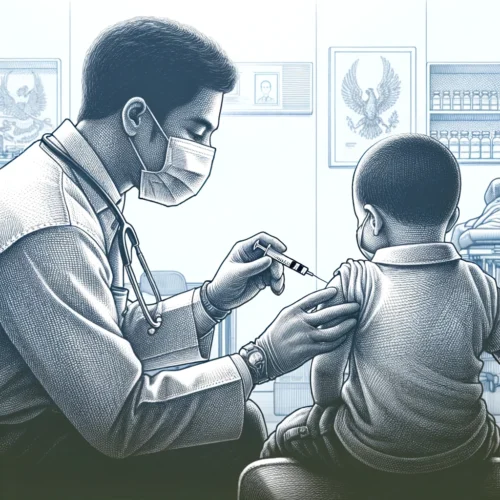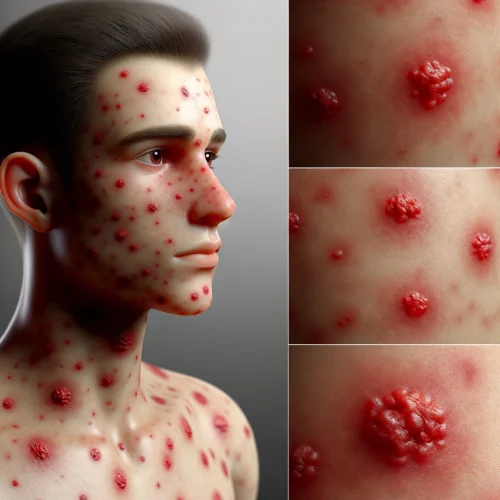
Measles is a highly contagious viral disease that remains a significant cause of morbidity and mortality globally, despite the availability of an effective vaccine. Caused by the measles virus, a member of the paramyxovirus family, it primarily spreads through respiratory droplets from coughs and sneezes of infected individuals. The infection can affect individuals of all ages but is most severe in children under five years and adults over 30. Its high contagion rate underscores the importance of understanding and addressing this public health challenge.
The clinical manifestations of measles begin with a prodromal phase characterized by high fever, cough, runny nose, conjunctivitis, and the distinctive Koplik spots inside the mouth, followed by the hallmark red, blotchy rash that spreads across the body. However, the disease’s impact goes beyond these symptoms, as the infection can lead to serious complications such as pneumonia, encephalitis, and even death, particularly in malnourished children and individuals with compromised immune systems.
Awareness and vaccination are pivotal in the fight against measles. The measles vaccine, usually administered as part of the Measles-Mumps-Rubella (MMR) combination, has dramatically reduced cases of the condition worldwide. Yet, vaccine hesitancy and access issues have led to outbreaks, even in regions previously near elimination. The importance of vaccination cannot be overstated; it not only protects the vaccinated individual but also contributes to herd immunity, reducing the chances of outbreak and protecting those who are unable to receive the vaccine due to medical conditions.
Measles – How The Infection Develops and Spreads
The measles virus is a highly infectious agent responsible for causing measles, a disease known for its distinctive rash and the potential for severe health complications. Classified under the genus Morbillivirus within the family Paramyxoviridae, the measles virus is a single-stranded, negative-sense RNA virus. Its structure facilitates rapid replication and transmission, primarily through respiratory droplets, enabling it to spread efficiently among humans. Once a mainstay of childhood diseases, measles has seen a significant reduction in incidence rates thanks to the widespread use of the measles vaccine. However, the virus’s ability to mutate, combined with gaps in vaccination coverage, poses ongoing challenges to public health efforts aimed at its eradication.
Globally, measles epidemiology presents a complex picture, with varying incidence rates across different regions and among populations. The World Health Organization (WHO) has reported significant progress in reducing the infectious disease cases worldwide through extensive immunization programs. Yet, recent years have witnessed outbreaks in regions previously nearing elimination, highlighting the disease’s persistent threat. These outbreaks often occur in communities with low vaccination rates, in countries with weak healthcare systems, and in areas experiencing conflict or mass migration, where immunization efforts are disrupted. High-income countries are not immune to outbreaks, as seen in parts of Europe and the United States, where vaccine hesitancy has led to decreased immunization coverage.
The resurgence of measles in certain areas can be attributed to several key factors. Foremost among these is vaccine hesitancy, fueled by misinformation and skepticism about vaccine safety and efficacy. This hesitancy undermines herd immunity, the critical mass of immunized individuals needed to prevent the spread of the virus to those who are unvaccinated or cannot be vaccinated due to medical reasons. Additionally, global travel facilitates the rapid spread of the infection from regions with endemic transmission to those with previously controlled or eliminated disease, reintroducing the virus to susceptible populations.
Access to healthcare services also plays a significant role in the epidemiology of measles. In resource-limited settings, barriers to accessing vaccination services, such as cost, availability, and distance, can leave children unvaccinated and vulnerable to measles and its complications. Political instability and conflict further exacerbate these challenges, disrupting routine immunization activities and leading to vaccination gaps among the population.
Public health infrastructure and surveillance systems are crucial in managing measles outbreaks. Effective surveillance allows for the early detection of cases, enabling timely responses to contain outbreaks before they spread widely. However, in many regions, surveillance systems are underfunded or lack the necessary capacity to monitor and respond to the infection effectively, allowing the virus to circulate unchecked.
Main Symptoms And Clinical Presentation in Measles
Measles, a disease as old as civilization itself, presents a clinical picture that, despite advancements in medicine, remains largely unchanged. The disease’s course can be delineated into distinct phases, beginning with an incubation period, followed by the prodromal phase, and culminating in the appearance of the characteristic measles rash. Understanding the clinical presentation of measles is crucial for timely diagnosis and management, especially in the context of preventing further spread.
The incubation period of measles, the time from exposure to the virus to the onset of symptoms, typically ranges from 10 to 14 days. This asymptomatic phase belies the contagious nature of the disease, as individuals are not yet aware of their infection. Following this, the prodromal phase marks the initial appearance of symptoms. This phase is characterized by a constellation of signs including high fever, which can soar above 40°C (104°F), malaise, cough, conjunctivitis, and coryza. Notably, Koplik spots—small, white lesions on a reddish background, appearing inside the mouth—emerge around two days before the rash and serve as a hallmark sign, aiding in the early diagnosis of measles.
The measles rash itself is a defining feature of the disease, appearing approximately 14 days after exposure to the virus. It starts on the face and upper neck, gradually spreading downward to cover the trunk and then the arms and legs. The rash is maculopapular, meaning it consists of red spots that are slightly raised. Initially discrete, these spots may coalesce into larger, blotchy areas as the rash spreads. The rash’s progression is typically accompanied by a spike in fever, which may peak as the rash emerges.
The typical course of measles, from the onset of the prodromal symptoms to rash resolution, usually spans about 7 to 10 days. The fever and rash generally begin to subside after a few days, though a sense of malaise and a cough may persist for several days more. The entire duration of the illness, from exposure to full recovery, can extend up to three weeks, during which the infected individual is highly contagious, especially in the four days before and after the rash appears. The virus’s high transmissibility during this period underscores the importance of isolating suspected cases to prevent outbreaks.
Common Complications in Measles
Measles, while often perceived as a benign childhood illness, can lead to a range of complications that vary in severity and impact. These complications can exacerbate the disease’s burden, particularly in vulnerable populations, and contribute significantly to the global health challenges associated with measles. Among the most common complications are otitis media, pneumonia, and diarrhea, each affecting the body in various detrimental ways.
Otitis media, an infection of the middle ear, frequently occurs in children suffering from measles. This complication can lead to hearing loss if not promptly and effectively treated. Pneumonia, a serious infection of the lungs, is another common complication and the leading cause of measles-related deaths, especially in young children and immunocompromised individuals. Diarrhea, though often overlooked, can have profound effects on health, leading to dehydration and worsening the nutritional status of affected individuals, thereby compounding the disease’s severity.
Beyond these common complications, measles can also lead to severe, life-threatening conditions such as encephalitis and subacute sclerosing panencephalitis (SSPE). Encephalitis, an inflammation of the brain, can occur in the immediate aftermath of measles infection, leading to seizures, neurological damage, and even death. SSPE, a rare but fatal degenerative disease of the central nervous system, manifests years after a measles infection, highlighting the long-term impact of the virus.
The risk of developing complications from measles is not uniformly distributed. Several factors increase the likelihood of severe disease, including malnutrition, vitamin A deficiency, immunosuppression, and having either very young or older age. These risk factors underscore the importance of targeting vulnerable populations with effective measles vaccination campaigns and supportive care measures to mitigate the risk of complications and reduce the overall disease burden.
How to Diagnose Measles and The Current Clinical Criteria for Diagnosis
Diagnosing measles involves a combination of clinical assessment and laboratory testing, given the disease’s distinctive presentation yet potential similarity to other febrile rash illnesses. Early and accurate diagnosis is crucial not only for appropriate patient management but also for initiating public health measures to prevent further spread of the virus.
Clinical Criteria for Diagnosis
The diagnosis of measles typically begins with the identification of its characteristic clinical features. Health care providers look for the four D’s: cough, coryza (runny nose), conjunctivitis (red eyes), and fever, which precede the onset of rash by several days. The appearance of Koplik spots—tiny white spots on the inside of the mouth—is considered pathognomonic for measles and, when present, strongly suggests the diagnosis. Following these initial symptoms, the emergence of a maculopapular rash, spreading from the face to the rest of the body, further supports the clinical suspicion of measles. However, because these signs and symptoms are not exclusive to measles, laboratory confirmation is essential for definitive diagnosis.
Laboratory Tests for Confirmation
Laboratory testing plays a pivotal role in the confirmation of measles. Serological testing, specifically IgM antibody detection in serum collected at the onset of the rash, is a commonly used method. The presence of measles-specific IgM antibodies indicates recent infection. However, in the first 72 hours of the rash, IgM detection might be negative, and the test may need to be repeated if clinical suspicion remains high.
Polymerase chain reaction (PCR) testing offers a more sensitive and specific approach, allowing for the detection of measles virus RNA from respiratory specimens, urine, or blood. PCR not only confirms the diagnosis but can also be used for genotyping the virus, aiding in epidemiological tracking and outbreak management. Given its high sensitivity, PCR is particularly useful in the early stages of the disease and in cases where serology might be inconclusive.
Differential Diagnoses to Consider
Several other diseases can mimic the presentation of measles, making differential diagnosis an important part of the clinical evaluation. Rubella (German measles), roseola (sixth disease), and enterovirus infections, including hand, foot, and mouth disease, all present with fever and rash and must be considered. Additionally, parvovirus B19 infection (fifth disease) and adenovirus can produce similar symptoms. In regions where dengue or Zika virus infections are prevalent, these diseases should also be included in the differential diagnosis, as both can present with fever and rash. Distinguishing measles from these conditions relies on a careful evaluation of clinical features, epidemiological context, and, critically, laboratory testing.
The management of measles, a highly contagious viral disease, is primarily supportive, as no specific antiviral therapy exists for the measles virus. Treatment focuses on alleviating symptoms, preventing complications, and supporting the body’s immune response to the infection. Additionally, preventive measures, particularly vaccination, play a crucial role in controlling the spread of measles and minimizing its public health impact.
Supportive Care Measures
Supportive care for measles is aimed at relieving symptoms and includes adequate hydration, rest, and the use of antipyretics to manage fever. Fever and pain can be managed with medications such as acetaminophen or ibuprofen, but aspirin should be avoided in children due to the risk of Reye’s syndrome. For those with severe coughing or throat irritation, humidified air and throat lozenges may provide some relief. Isolation from others, especially unvaccinated individuals and those at high risk for severe disease, is recommended to prevent transmission.
Management of Complications
Complications from measles, such as otitis media, pneumonia, and diarrhea, require targeted treatment. Antibiotics may be prescribed for bacterial superinfections, such as otitis media and pneumonia. Rehydration solutions or intravenous fluids may be necessary for severe diarrhea or dehydration. Close monitoring is essential, especially in young children, the immunocompromised, and malnourished individuals, to promptly identify and treat complications.
Role of Vitamin A in Treatment Protocols
Vitamin A supplementation has been shown to reduce the severity and mortality associated with measles. The World Health Organization (WHO) recommends administering two doses of vitamin A, 24 hours apart, to all children diagnosed with measles, especially those at high risk of vitamin A deficiency. This intervention can mitigate the risk of eye damage and blindness, reduce the severity of diarrhea, and improve overall survival rates.
Importance of Vaccination
Vaccination is the cornerstone of measles prevention and control. The measles-mumps-rubella (MMR) vaccine is highly effective in preventing measles infection. Two doses of the MMR vaccine are about 97% effective at preventing measles, while one dose is about 93% effective. Widespread vaccination has led to a significant reduction in measles cases globally, and in some regions, the elimination of endemic measles transmission.
Herd Immunity and Its Role in Preventing Outbreaks
Herd immunity occurs when a high percentage of the population is immune to a disease, either through vaccination or previous infection, reducing the likelihood of disease spread. This protection is crucial for individuals who cannot be vaccinated, such as newborns, those with certain medical conditions, or immunocompromised individuals. For measles, achieving and maintaining a vaccination coverage of at least 95% with two doses is necessary to establish herd immunity and prevent outbreaks.
Current Recommendations for Vaccination Schedules
The current recommendations for the MMR vaccine include two doses: the first dose at 12 to 15 months of age and the second dose at 4 to 6 years of age. However, in areas with high risk of measles or during outbreaks, the vaccine may be administered to infants as young as 6 months, with subsequent doses following the standard schedule. Catch-up vaccination is advised for anyone who has not been fully vaccinated.
The public health implications of measles are profound, given its high contagion and potential for severe outcomes. Strategies for measles control and elimination hinge on comprehensive vaccination campaigns, robust surveillance systems, and public education to maintain high levels of immunity within communities. The goal of these strategies is not only to prevent outbreaks but also to achieve and sustain elimination of the disease. Key to this effort is the widespread administration of the measles-mumps-rubella (MMR) vaccine, as recommended by public health authorities worldwide. Implementing catch-up vaccination programs for unvaccinated populations and ensuring timely vaccination according to the recommended schedules are critical components of these strategies.
However, achieving high vaccination coverage and sustaining measles elimination face several challenges. In some regions, logistical hurdles such as vaccine supply chain issues, inadequate healthcare infrastructure, and limited access to healthcare services impede vaccination efforts. Political and economic instability can further exacerbate these challenges, disrupting routine immunization activities. Additionally, vaccine hesitancy, fueled by skepticism and misinformation about vaccine safety and efficacy, poses a significant barrier to achieving the necessary coverage rates for herd immunity.
Misinformation about vaccines has a particularly insidious impact on public health efforts. In the age of social media, myths and unfounded fears about vaccination can spread rapidly, undermining trust in vaccines and leading to decreased vaccination rates. This erosion of public confidence contributes to the resurgence of measles in areas previously close to elimination. Combatting misinformation and reinforcing the importance of vaccination through evidence-based public health messaging are crucial to counteract these trends and protect populations from measles.
Addressing these challenges requires a multifaceted approach that includes strengthening healthcare systems, enhancing surveillance and response capacities, and engaging communities through targeted education and communication strategies. Collaboration between governments, international organizations, healthcare providers, and communities is essential to overcome barriers to vaccination and move closer to the goal of global measles elimination.
Article by Dr Tsanko Stefanov

